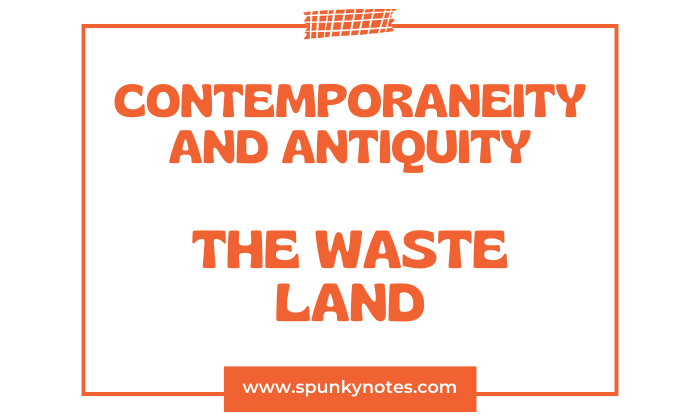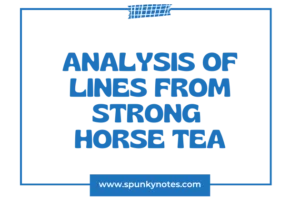
Q. What are some of the parallels that Eliot draws between contemporaneity and antiquity in ‘The Waste Land’?
Introduction
T.S. Eliot’s poem “The Waste Land” profoundly reflects on the decay and disillusionment of post-World War I society. It interweaves many voices, cultural references, and historical periods to comment on the fragmented state of modern civilization.
The poem opens by depicting a spiritually empty and culturally stagnant world, suggesting a deep loss of direction and purpose in contemporary life.
Eliot draws on an extensive range of sources, from ancient texts and myths to contemporary music and literature, indicating that the problems of his time echo those of the past.
Through characters like Tiresias, who observes both ancient and modern worlds, Eliot emphasizes the continuous human struggle across eras. The poem’s use of different languages and allusions highlights the chaos and confusion of the 20th century.
Characters and Myths
In “The Waste Land,” T.S. Eliot integrates characters and myths from various ancient cultures, including Greek, Roman, and Egyptian mythologies, to underline the timeless nature of human difficulties.
One prominent character is Tiresias, a blind prophet from Greek mythology. He appears as a central figure witnessing events across different epochs. His presence in the poem emphasizes that human conflicts and societal issues persist throughout the ages.
Additionally, Eliot references the Fisher King from Arthurian legend, whose plight reflects the barrenness and despair of the modern world. This character’s struggle illustrates the need for healing and renewal within society.
Eliot also incorporates elements of Egyptian mythology, using images such as the dry, lifeless desert to symbolize the spiritual emptiness of contemporary life.
By connecting these ancient symbols and characters to the modern day, Eliot stresses that humanity’s challenges are not new and recur in every era. This approach helps readers see the modern world’s issues as part of a broader historical and cultural continuum.
Historical and Religious Texts
In “The Waste Land,” T.S. Eliot extensively uses historical and religious texts to highlight contemporary society’s moral and spiritual crises. He incorporates quotes and references from diverse sources, including the Bible, Dante’s “Divine Comedy,” and ancient Hindu scriptures.
This blending of texts creates a dialogue between past wisdom and present issues. For example, Eliot uses biblical references to portray a world straying from spiritual paths. It suggests a deep need for societal redemption and guidance.
The inclusion of Dante’s work connects the poem’s themes of desolation and search for meaning to the classical journey through Hell, Purgatory, and Paradise. It emphasizes the idea of a spiritual journey and moral testing.
Meanwhile, references to Eastern religious texts, like the Upanishads, introduce concepts of spiritual renewal and enlightenment that contrast sharply with the poem’s depiction of a barren modern world.
In “The Waste Land,” Eliot not only bridges historical and cultural gaps but also calls attention to the recurring nature of human spiritual quests and the constant need for moral guidance in every age.
Societal Decay
In “The Waste Land,” T.S. Eliot powerfully depicts societal decay that reflects the disillusionment and disorientation of the post-World War I era. He portrays modern society as a wasteland, a barren landscape where cultural and moral values have deteriorated.
This imagery of decay is used throughout the poem to represent contemporary civilization’s physical and spiritual breakdown.
Eliot illustrates this decline by comparing Europe’s present state to fallen ancient civilizations such as Rome and Egypt. This suggests that history is cyclical, with societies rising and then falling into decay.
The poem’s vivid descriptions of a desolate environment, with cities described as unreal and sterile land, underline the severity of this cultural and moral collapse.
The depiction of societal decay in “The Waste Land” critiques modern life. Eliot sees a loss of purpose and a lack of spiritual direction.
He uses this portrayal to express his concern about society’s direction and to highlight the need for reviving values that have been lost in the chaos of modernity.
Critique of Modern Life
In “The Waste Land,” T.S. Eliot critiques modern life, depicting it as spiritually empty and morally bankrupt. He portrays contemporary society through a fragmented structure that reflects disconnection and isolation. Eliot uses multiple voices to highlight the breakdown of the community.
For instance, the disjointed verses and shifting scenes underscore the lack of unity in society. Eliot also trivially references popular culture, such as in “A Game of Chess,” where he includes lines from a music hall song that diminish the depth of cultural experiences.
This example illustrates how modern culture often prioritizes entertainment over meaningful engagement. Urban life is critiqued through the imagery of the polluted Thames River in “The Fire Sermon.” It symbolizes both environmental degradation and the tainted moral state of society.
Additionally, Eliot presents personal relationships as superficial, exemplified by the mechanical and emotionless encounter between the typist and the young man carbuncular, suggesting that interactions have become transactional.
Conclusion
In “The Waste Land,” Eliot uses parallels between ancient and modern worlds to discuss human struggles’ continuous and universal nature. By referring to the past, he not only shows the repetitive patterns of history but also criticizes his own time’s failures.
These connections are meant to remind the reader of what was lost and what could still be regained if society sought out and embraced the enduring values found in ancient wisdom.
The poem acknowledges and addresses the ongoing cultural and spiritual decline. It suggests that looking back at history might provide solutions for the future.
